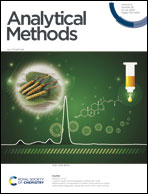Evaluation of different strategies for determination of selenomethionine (SeMet) in selenized yeast by asymmetrical flow field flow fractionation coupled to inductively coupled plasma mass spectrometry (AF4-ICP-MS)†
Abstract
This manuscript exemplifies the prospective use of asymmetrical flow field flow fractionation (AF4) coupled to inductively coupled plasma mass spectrometry (ICP-MS) as a simple tool for chemical speciation of selenomethionine (SeMet) in selenized yeast. Several popular sample preparation methods were evaluated for their suitability to determine selenomethionine (SeMet) in selenized yeast by AF4-ICP-MS. These included water, methanesulfonic acid (MSA), formic acid (FA) and alkaline extractions. Alkaline extraction (using sodium dodecyl sulfate buffer) provided the best recovery/determination conditions for SeMet based on analysis of NRC certified reference material (CRM) SELM-1 since it minimized hydrolysis of the protein peptide bonds optimally required for the AF4 separation. The analytical performance of three different AF4 membranes (5, 10 and 500 kDa regenerated cellulose) was also evaluated. No significant difference in the recovery of SeMet was observed when using 5 and 10 kDa RC membranes, whereas the 500 kDa membrane resulted in a significant loss. The proposed method presents appropriate instrument and intra-assay precisions of 4.4–9.2% and 3.8% RSD, respectively, a detection limit of 0.49 μg L−1 SeMet as Se and good linearity with correlation coefficients (R) between 0.996 – 0.999. This is the first report of use of AF4-ICP-MS for species specific quantitation of SeMet in selenized yeast demonstrating its efficient use as an alternative method to other traditional chromatographic techniques.



 Please wait while we load your content...
Please wait while we load your content...